|
Some disasters attributable to bad numerical computing
|
Have you been paying attention in your numerical analysis or scientific
computation courses? If not, it could be a costly mistake. Here
are some real life examples of what can happen when numerical
algorithms are not correctly applied.
The Patriot Missile Failure
The Patriot Missile failure in Dharan, Saudi Arabia, on February 25,
1991 which resulted in 28 deaths, is ultimately attributable to poor
handling of rounding errors.
On February 25, 1991, during the Gulf War, an American Patriot Missile
battery in Dharan, Saudi Arabia, failed to track and intercept an
incoming Iraqi Scud missile. The Scud struck an American Army
barracks, killing 28 soldiers and injuring around 100 other people.
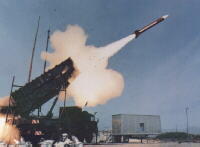 A report of the General
Accounting office, GAO/IMTEC-92-26,
entitled Patriot Missile Defense: Software Problem Led to System
Failure at Dhahran, Saudi Arabia reported on the cause of the
failure. It turns out that the cause was an inaccurate calculation of
the time since boot due to computer arithmetic errors. Specifically,
the time in tenths of second as measured by the system's internal
clock was multiplied by 1/10 to produce the time in seconds. This
calculation was performed using a 24 bit fixed point register. In
particular, the value 1/10, which has a non-terminating binary
expansion, was chopped at 24 bits after the radix point. The small
chopping error, when multiplied by the large number giving the time in
tenths of a second, lead to a significant error. Indeed, the Patriot
battery had been up around 100 hours, and an easy calculation shows
that the resulting time error due to the magnified chopping error was
about 0.34 seconds. (The number 1/10 equals
1/24+1/25+1/28+1/29+1/212
+1/213+.... In other words, the binary expansion of
1/10 is 0.0001100110011001100110011001100.... Now the 24 bit register
in the Patriot stored instead 0.00011001100110011001100 introducing an
error of 0.0000000000000000000000011001100... binary, or about
0.000000095 decimal. Multiplying by the number of tenths of a second
in 100 hours gives 0.000000095×100×60×60×10=0.34.)
A Scud travels at about 1,676 meters per second, and so travels more
than half a kilometer in this time. This was far enough that the
incoming Scud was outside the "range gate" that the Patriot tracked.
Ironically, the fact that the bad time calculation had been improved
in some parts of the code, but not all, contributed to the problem,
since it meant that the inaccuracies did not cancel.
A report of the General
Accounting office, GAO/IMTEC-92-26,
entitled Patriot Missile Defense: Software Problem Led to System
Failure at Dhahran, Saudi Arabia reported on the cause of the
failure. It turns out that the cause was an inaccurate calculation of
the time since boot due to computer arithmetic errors. Specifically,
the time in tenths of second as measured by the system's internal
clock was multiplied by 1/10 to produce the time in seconds. This
calculation was performed using a 24 bit fixed point register. In
particular, the value 1/10, which has a non-terminating binary
expansion, was chopped at 24 bits after the radix point. The small
chopping error, when multiplied by the large number giving the time in
tenths of a second, lead to a significant error. Indeed, the Patriot
battery had been up around 100 hours, and an easy calculation shows
that the resulting time error due to the magnified chopping error was
about 0.34 seconds. (The number 1/10 equals
1/24+1/25+1/28+1/29+1/212
+1/213+.... In other words, the binary expansion of
1/10 is 0.0001100110011001100110011001100.... Now the 24 bit register
in the Patriot stored instead 0.00011001100110011001100 introducing an
error of 0.0000000000000000000000011001100... binary, or about
0.000000095 decimal. Multiplying by the number of tenths of a second
in 100 hours gives 0.000000095×100×60×60×10=0.34.)
A Scud travels at about 1,676 meters per second, and so travels more
than half a kilometer in this time. This was far enough that the
incoming Scud was outside the "range gate" that the Patriot tracked.
Ironically, the fact that the bad time calculation had been improved
in some parts of the code, but not all, contributed to the problem,
since it meant that the inaccuracies did not cancel.
The following paragraph is excerpted from the GAO report:
"The range gate's prediction of where the Scud will next appear is a
function of the Scud's known velocity and the time of the last radar
detection. Velocity is a real number that can be expressed as a whole
number and a decimal (e.g., 3750.2563...miles per hour). Time is kept
continuously by the system's internal clock in tenths of seconds but
is expressed as an integer or whole number (e.g., 32, 33, 34...). The
longer the system has been running, the larger the number representing
time. To predict where the Scud will next appear, both time and
velocity must be expressed as real numbers. Because of the way the
Patriot computer performs its calculations and the fact that its
registers are only 24 bits long, the conversion of time from an
integer to a real number cannot be any more precise than 24 bits.
This conversion results in a loss of precision causing a less accurate
time calculation. The effect of this inaccuracy on the range gate's
calculation is directly proportional to the target's velocity and the
length of the the system has been running. Consequently, performing
the conversion after the Patriot has been running continuously for
extended periods causes the range gate to shift away from the center
of the target, making it less likely that the target, in this case a
Scud, will be successfully intercepted."
The Explosion of the Ariane 5
The explosion of the Ariane 5 rocket just after lift-off on its
maiden voyage off French Guiana, on June 4, 1996, was ultimately the
consequence of a simple overflow.
On June 4, 1996 an unmanned Ariane 5 rocket launched by the European
Space Agency exploded just forty seconds after its lift-off from
Kourou, French Guiana.
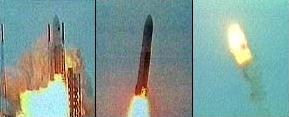 The rocket was on its first
voyage, after a decade of development costing $7 billion. The
destroyed rocket and its cargo were valued at $500 million. A board
of inquiry investigated the causes of the explosion and in two weeks
issued a report. It turned out that the cause of the failure was a
software error in the inertial reference system. Specifically a 64
bit floating point number relating to the horizontal velocity of the
rocket with respect to the platform was converted to a 16 bit signed
integer. The number was larger than 32,768, the largest integer
storeable in a 16 bit signed integer, and thus the conversion failed.
The rocket was on its first
voyage, after a decade of development costing $7 billion. The
destroyed rocket and its cargo were valued at $500 million. A board
of inquiry investigated the causes of the explosion and in two weeks
issued a report. It turned out that the cause of the failure was a
software error in the inertial reference system. Specifically a 64
bit floating point number relating to the horizontal velocity of the
rocket with respect to the platform was converted to a 16 bit signed
integer. The number was larger than 32,768, the largest integer
storeable in a 16 bit signed integer, and thus the conversion failed.
The following paragraphs are extracted from the
report of the Inquiry Board. An interesting article on
the accident and its implications by James Gleick appeared in The New
York Times Magazine of 1 December 1996. The CNN article
reporting the explosion, from which the above graphics were taken,
is also available.
On 4 June 1996, the maiden flight of the Ariane 5 launcher ended in a
failure. Only about 40 seconds after initiation of the flight sequence,
at an altitude of about 3700 m, the launcher veered off its flight path,
broke up and exploded.
The failure of the Ariane 501 was caused by the complete loss of
guidance and attitude information 37 seconds after start of the main
engine ignition sequence (30 seconds after lift-off). This loss of
information was due to specification and design errors in the software
of the inertial reference system.
The internal SRI* software exception was caused during execution of a
data conversion from 64-bit floating point to 16-bit signed integer
value. The floating point number which was converted had a value greater
than what could be represented by a 16-bit signed integer.
*SRI stands for Système de
Référence Inertielle or Inertial Reference System.
The sinking of the Sleipner A offshore platform
The sinking of the Sleipner A offshore platform in Gandsfjorden near
Stavanger, Norway, on August 23, 1991, resulted in a loss of nearly
one billion dollars. It was found to be the result of inaccurate
finite element analysis.
Excerpted from SINTEF, Civil
and Environmental Engineering:
The Sleipner A platform produces oil and gas in the North Sea and is
supported on the seabed at a water depth of 82 m. It is a Condeep type
platform with a concrete gravity base structure consisting of 24 cells
and with a total base area of 16 000 m2. Four cells are elongated to
shafts supporting the platform deck. The first concrete base structure
for Sleipner A sprang a leak and sank under a controlled ballasting
operation during preparation for deck mating in Gandsfjorden outside
Stavanger, Norway on 23 August 1991.
Immediately after the accident, the owner of the platform, Statoil, a
Norwegian oil company appointed an investigation group, and SINTEF was
contracted to be the technical advisor for this group.
The investigation into the accident is described in 16 reports...
The conclusion of the investigation was that the loss was caused by
a failure in a cell wall, resulting in a serious crack and a leakage
that the pumps were not able to cope with. The wall failed as a
result of a combination of a serious error in the finite element
analysis and insufficient anchorage of the reinforcement in a critical
zone.
A better idea of what was involved can be obtained from this photo and
sketch of the platform.
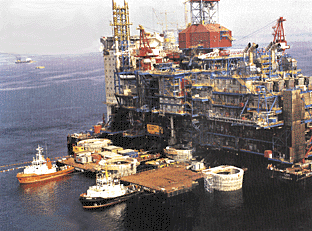
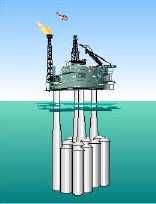 The top deck weighs 57,000 tons,
and provides accommodation for about 200 people and support for
drilling equipment weighing about 40,000 tons. When the first model
sank in August 1991, the crash caused a seismic event registering 3.0
on the Richter scale, and left nothing but a pile of debris at 220m of
depth. The failure involved a total economic loss of about $700
million.
The top deck weighs 57,000 tons,
and provides accommodation for about 200 people and support for
drilling equipment weighing about 40,000 tons. When the first model
sank in August 1991, the crash caused a seismic event registering 3.0
on the Richter scale, and left nothing but a pile of debris at 220m of
depth. The failure involved a total economic loss of about $700
million.
The 24 cells and 4 shafts referred to above are shown to the left
while at the sea surface.
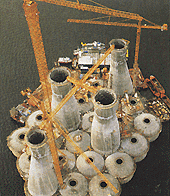
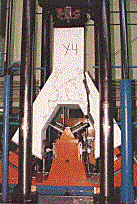 The cells are 12m in diameter.
The cell wall failure was traced to a tricell, a triangular concrete
frame placed where the cells meet. At right one is pictured
undergoing failure testing.
The cells are 12m in diameter.
The cell wall failure was traced to a tricell, a triangular concrete
frame placed where the cells meet. At right one is pictured
undergoing failure testing.
The post accident investigation traced the error to inaccurate finite
element approximation of the linear elastic model of the tricell
(using the popular finite element program NASTRAN). The shear
stresses were underestimated by 47%, leading to insufficient design.
In particular, certain concrete walls were not thick enough. More
careful finite element analysis, made after the accident, predicted
that failure would occur with this design at a depth of 62m, which
matches well with the actual occurrence at 65m.
Further information can be found in the series of
reports available for purchase from SINTEF and in an article from
Concrete International, August 1997, available online in an abridged
version from Engineers Australia.
 A report of the General
Accounting office, GAO/IMTEC-92-26,
entitled Patriot Missile Defense: Software Problem Led to System
Failure at Dhahran, Saudi Arabia reported on the cause of the
failure. It turns out that the cause was an inaccurate calculation of
the time since boot due to computer arithmetic errors. Specifically,
the time in tenths of second as measured by the system's internal
clock was multiplied by 1/10 to produce the time in seconds. This
calculation was performed using a 24 bit fixed point register. In
particular, the value 1/10, which has a non-terminating binary
expansion, was chopped at 24 bits after the radix point. The small
chopping error, when multiplied by the large number giving the time in
tenths of a second, lead to a significant error. Indeed, the Patriot
battery had been up around 100 hours, and an easy calculation shows
that the resulting time error due to the magnified chopping error was
about 0.34 seconds. (The number 1/10 equals
1/24+1/25+1/28+1/29+1/212
+1/213+.... In other words, the binary expansion of
1/10 is 0.0001100110011001100110011001100.... Now the 24 bit register
in the Patriot stored instead 0.00011001100110011001100 introducing an
error of 0.0000000000000000000000011001100... binary, or about
0.000000095 decimal. Multiplying by the number of tenths of a second
in 100 hours gives 0.000000095×100×60×60×10=0.34.)
A Scud travels at about 1,676 meters per second, and so travels more
than half a kilometer in this time. This was far enough that the
incoming Scud was outside the "range gate" that the Patriot tracked.
Ironically, the fact that the bad time calculation had been improved
in some parts of the code, but not all, contributed to the problem,
since it meant that the inaccuracies did not cancel.
A report of the General
Accounting office, GAO/IMTEC-92-26,
entitled Patriot Missile Defense: Software Problem Led to System
Failure at Dhahran, Saudi Arabia reported on the cause of the
failure. It turns out that the cause was an inaccurate calculation of
the time since boot due to computer arithmetic errors. Specifically,
the time in tenths of second as measured by the system's internal
clock was multiplied by 1/10 to produce the time in seconds. This
calculation was performed using a 24 bit fixed point register. In
particular, the value 1/10, which has a non-terminating binary
expansion, was chopped at 24 bits after the radix point. The small
chopping error, when multiplied by the large number giving the time in
tenths of a second, lead to a significant error. Indeed, the Patriot
battery had been up around 100 hours, and an easy calculation shows
that the resulting time error due to the magnified chopping error was
about 0.34 seconds. (The number 1/10 equals
1/24+1/25+1/28+1/29+1/212
+1/213+.... In other words, the binary expansion of
1/10 is 0.0001100110011001100110011001100.... Now the 24 bit register
in the Patriot stored instead 0.00011001100110011001100 introducing an
error of 0.0000000000000000000000011001100... binary, or about
0.000000095 decimal. Multiplying by the number of tenths of a second
in 100 hours gives 0.000000095×100×60×60×10=0.34.)
A Scud travels at about 1,676 meters per second, and so travels more
than half a kilometer in this time. This was far enough that the
incoming Scud was outside the "range gate" that the Patriot tracked.
Ironically, the fact that the bad time calculation had been improved
in some parts of the code, but not all, contributed to the problem,
since it meant that the inaccuracies did not cancel.
 The rocket was on its first
voyage, after a decade of development costing $7 billion. The
destroyed rocket and its cargo were valued at $500 million. A board
of inquiry investigated the causes of the explosion and in two weeks
issued a report. It turned out that the cause of the failure was a
software error in the inertial reference system. Specifically a 64
bit floating point number relating to the horizontal velocity of the
rocket with respect to the platform was converted to a 16 bit signed
integer. The number was larger than 32,768, the largest integer
storeable in a 16 bit signed integer, and thus the conversion failed.
The rocket was on its first
voyage, after a decade of development costing $7 billion. The
destroyed rocket and its cargo were valued at $500 million. A board
of inquiry investigated the causes of the explosion and in two weeks
issued a report. It turned out that the cause of the failure was a
software error in the inertial reference system. Specifically a 64
bit floating point number relating to the horizontal velocity of the
rocket with respect to the platform was converted to a 16 bit signed
integer. The number was larger than 32,768, the largest integer
storeable in a 16 bit signed integer, and thus the conversion failed.

 The top deck weighs 57,000 tons,
and provides accommodation for about 200 people and support for
drilling equipment weighing about 40,000 tons. When the first model
sank in August 1991, the crash caused a seismic event registering 3.0
on the Richter scale, and left nothing but a pile of debris at 220m of
depth. The failure involved a total economic loss of about $700
million.
The top deck weighs 57,000 tons,
and provides accommodation for about 200 people and support for
drilling equipment weighing about 40,000 tons. When the first model
sank in August 1991, the crash caused a seismic event registering 3.0
on the Richter scale, and left nothing but a pile of debris at 220m of
depth. The failure involved a total economic loss of about $700
million.

 The cells are 12m in diameter.
The cell wall failure was traced to a tricell, a triangular concrete
frame placed where the cells meet. At right one is pictured
undergoing failure testing.
The cells are 12m in diameter.
The cell wall failure was traced to a tricell, a triangular concrete
frame placed where the cells meet. At right one is pictured
undergoing failure testing.